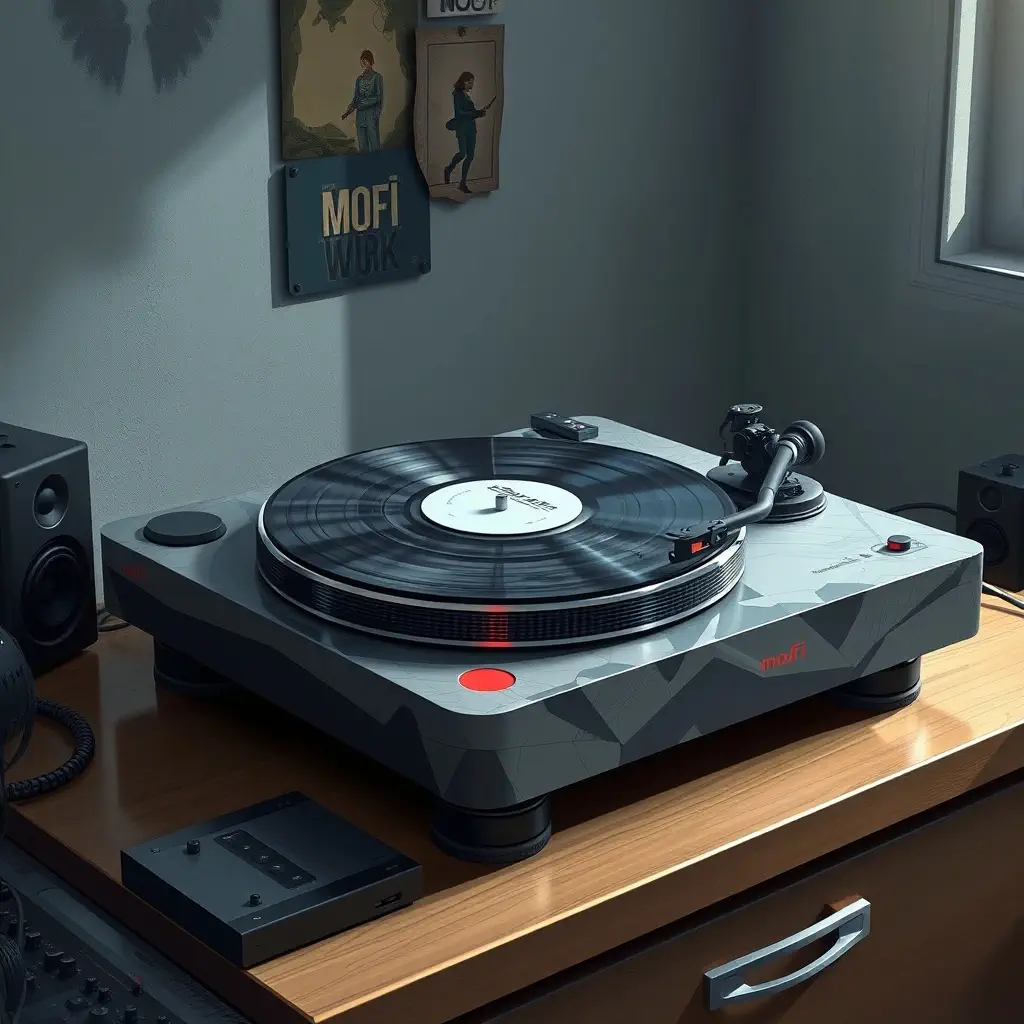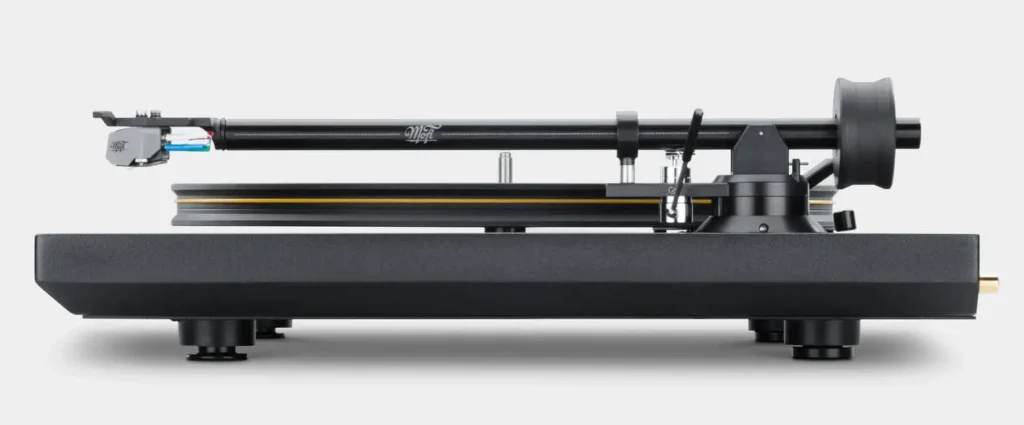MoFi is a hi-fi hardware manufacturer that could be better known. But in recent years, they’ve quietly developed a cool product lineup mostly for vinyl playback. They’ve even added speakers to the mix. MoFi’s parent brand, Mobile Fidelity Sound Labs, is known for making some of the best vinyl and digital recordings around. So, it makes sense for them to jump into the hi-fi market. That way, they can offer the right equipment to play their recordings. This article will provide an overview of MOFI StudioDeck and examine its other details. So let’s get started and take a look at MOFI StudioDeck:
Sound quality
The StudioDeck+ is as enthusiastic as its sibling, but it’s a bit more chilled out. It’s got a great sense of balance across the frequency range and doesn’t try to dazzle you with brilliance in one area while falling behind in others. The first thing that hit me was how well it performed. Even with a poorly recorded track, it doesn’t try to hide its flaws, but it does make the most of the musical message within.

The StudioTracker cartridge helps here, offering secure tracking and digging deeply into the grooves to find the best bits. However, it’s when you play something that’s well recorded, that it simply steps aside to let the music through; the slightly lower tracking distortion offered by the longer arm assists in making everything very pure, clean, and detailed.
StudioDeck+ handles bass lines like a champ. It doesn’t overpower the track, but it doesn’t disappear into the background either. It hits the sweet spot, just enough to make my floor vibrate on tracks like “Convergence” by Malia and Boris Blank. But it can also handle faster, punchier stuff without sounding like a herd of elephants.
I’m starting to think the deck is underperforming as I move up the bass spectrum. There’s a slight chestiness that’s noticeable, though it’s a bit better when I use the clamp. The vocals on “Nothing to Fear” by Chris Rea are a little too fruity and resonant for my taste. There’s also more surface noise than normal. I wonder if the cartridge is to blame, so I quickly swapped it out for an Ortofon 2M Black (HFC 434). That made everything tight and quiet again, and it became clear that a better cartridge would release even more magic from the turntable.
With the MoFi cartridge back in the game, the other aspects of its sound are impressive. It’s great at sound staging, with instruments and singers expertly arranged. The cymbal from the drum machine isn’t drowned out by the slide guitar that follows it.
Performance
I set up the turntable. The cartridge was in place, so I just had to hook the anti-skate weight on. Then I rolled the counterweight up the arm until the stylus force gauge read 2 grams.
To set up the turntable, you’ll need a stylus gauge.
Mo-Fi doesn’t include one, so they assume you already have one. I used one that came with a (cheaper) Thorens turntable. I also used their alignment protractor to make sure the cartridge was mounted right.

We put together our gear and started with side six of Satyagraha by Philip Glass.
We wanted to ease into it, so we dropped the needle before switching our amp to the phono stage. We were in a hurry, and it showed. When we turned it on, there was nothing. We cranked it up, then up again, and finally heard some low vinyl surface noise.
Then a set of pulsing flutes burst onto the sound stage at great level and absolute reality, joined shortly by the New York City Opera Chorus presented with a clarity and depth as to be entirely hypnotic. It was a fine first burst to introduce the deck’s characteristics of extremely low surface noise (given a clean disc) and tight timing.
The trick was repeated with Band on the Run, which has a great 1997 “EMI 100” pressing. The opening is a tonal delight, with zinging treble and edgy guitars. The twinned vocals are perfectly formed and centered in the mix, with a recorded acoustic presenting them at a little distance.
This is a highly accurate delivery from the outer edge of the arm’s motion.
I just bought the MoFi StudioDeck turntable, and I think it’s awesome. The sound is super clear, especially the bass. The turntable also has an “open ceiling” effect, which makes the sound resonate really well. I’m stoked with this purchase.
This turntable is not kind to dirty vinyl. But that’s true of all good hi-fi systems. So, we recommend you also buy a vinyl cleaning system when you get your turntable.
Setup
I just got the StudioDeck set up. The instructions were clear and easy to follow. I especially liked the nests that held the platter, power cord, drive belt, paper tubes, and bumpers. I also liked that the StudioDeck+ package I got came with the StudioTracker cartridge already installed, which made setup even easier. Thanks, MoFi!

To help you set the tonearm’s counterweight, the arm stub has a bit of white tape that says, “Put counterweight here.” I had to fine-tune it a bit, but the “factory setting” was pretty close. High-Fidelity Vinyl Playback Review
I had three annoying setup issues. First, MoFi assumes you have a stylus-pressure gauge. Second, they expect you to have a bubble level to get the StudioDeck perfectly level. Third, you have to adjust the height of the vibration-damping feet. That’s a lot of tools for a setup!
This small weight is attached to a fine thread, at the end of which is a loop with a soft rubber ring. The goal is to thread this string over and through a slot in the rear of a small post that rises from the base of the arm’s pivot, and then bends to extend behind the pivot.
This can be tough. You need good vision, slender fingers, and lots of patience. If your StudioDeck has a preinstalled StudioTracker cartridge, you need to put the rubber ring on the second detent on the post. The weight of the cartridge tells you which detent to use.
After a lot of fiddling and the help of some small needle-nose pliers, I was finally able to get the ring on the post. Once it’s done, you probably won’t have to mess with it again unless you get a different cartridge.
Comparison
I got my Dual CS5000 turntable a long time ago for $699. For years I used it with a Shure V15 Type V-MR cartridge. In all that time I’ve checked out a lot of turntables, but none of them sounded as good as my Dual until I got the StudioDeck+. High-Fidelity Vinyl Playback Review
I just listened to Art Garfunkel’s “Finally Found a Reason.” The song sounded great, just like I expected it to. The guitar was semi-delicate, and the bass was solid but not overpowering. The backup singers blended in perfectly. I especially liked the guitar articulation and the way Garfunkel’s voice sounded so ethereal. They were all clustered around him, which made for a very satisfying performance.

I got my Dual CS5000 turntable a long time ago for $699. For years I used it with a Shure V15 Type V-MR cartridge. In all that time I’ve checked out a lot of turntables, but none of them sounded as good as my Dual until I got the StudioDeck+.
I just listened to Art Garfunkel’s “Finally Found a Reason.” The song sounded great, just like I expected it to. The guitar was semi-delicate, and the bass was solid but not overpowering. The backup singers blended in perfectly. I especially liked the guitar articulation and the way Garfunkel’s voice sounded so ethereal. They were all clustered around him, which made for a very satisfying performance. High-Fidelity Vinyl Playback Review
The StudioDeck+ turntable is way better than my Dual CS5000 turntable with a Shure V15 Type V-MR cartridge. The StudioDeck+ has a totally “black” background, which means no noise at all. The guitar is a little cleaner, the bass is more authoritative, and the backup singers sound like they are a few feet behind Garfunkel instead of right next to him.
Features
- 33-1/3 and 45.0 RPM belt drive turntable
- Custom design and manufactured in the USA
- 10-inch MoFi Studio Tonearm
- 3/4-inch Delrin platter
- Isolated 300 RPM AC synchronous motor
- Anti-vibration feet designed by HRS
Specifications
- Type: Periphery-driven belt drive turntable with moving-magnet cartridge
- Motor: 300 RPM AC Synchronous
- Speed change: Manual, via stepped pulleys
- Tonearm: 10″ (254mm) straight aluminum with gimbaled bearing
- Outputs: Mains and twin RCA with earth point
- Cartridge: Moving magnet with V-twin dual-magnet generators and elliptical stylus. 47kOhm impedance, 100pF capacitance, 3.5mV output voltage and 20–20,000Hz frequency response
- Weight: 8.6kg
- Dimensions: 500 x 137 x 362mm (WHD)
Conclusion
I just bought the StudioDeck+ and it was a breeze to set up. I really like using it. The bundled cartridge that comes with it is a nice bonus, and I was able to upgrade it easily. The UltraDeck is a better deck than the StudioDeck+ in some ways, but the price difference is more than I thought it would be. High-Fidelity Vinyl Playback Review



